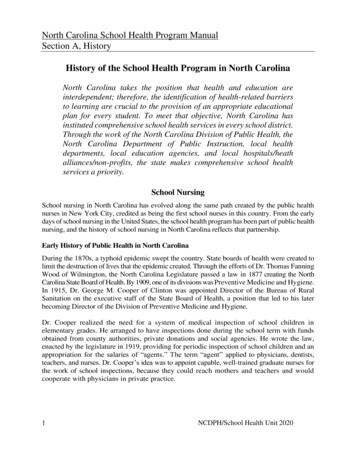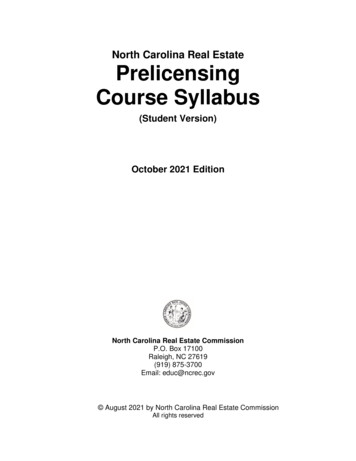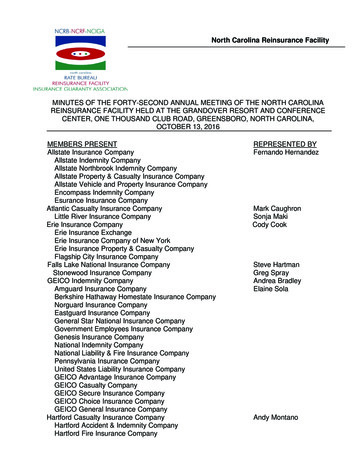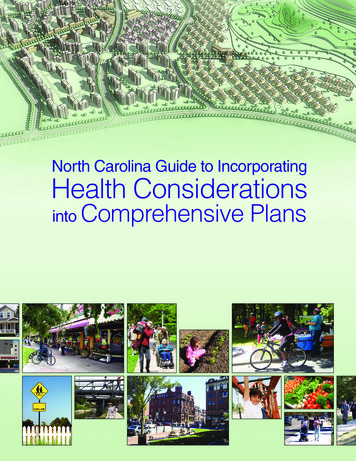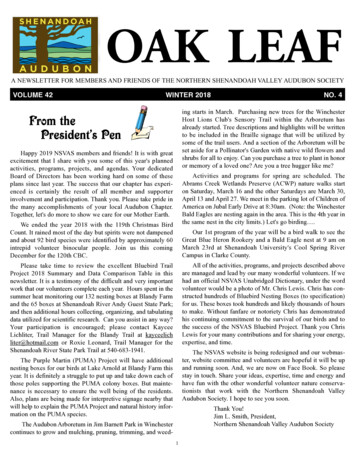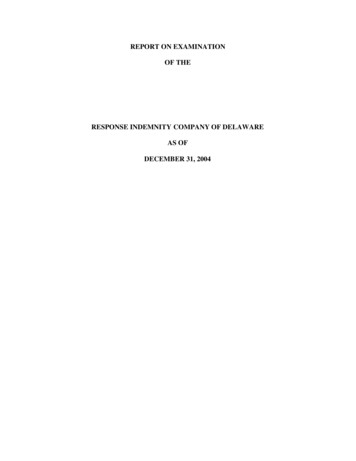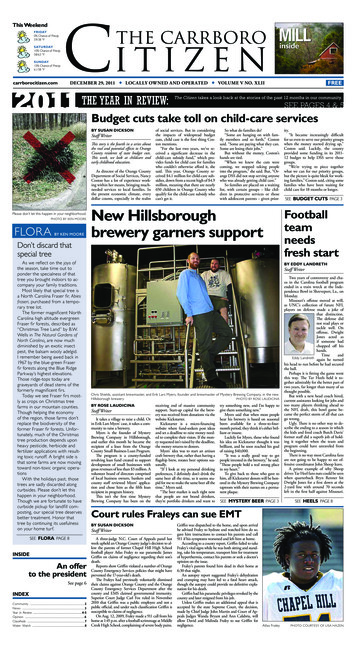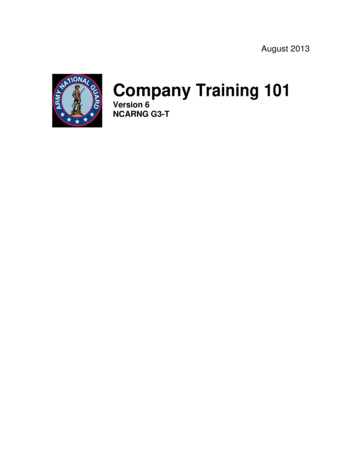
Transcription
August 2013Company Training 101Version 6NCARNG G3-T
Company Training 101August 2013Table of ContentOVERVIEWMust Reads & Desk ReferencesRequirementMissionMission Focus and METLEnd State22233COMPANY-LEVEL TRAININGTraining Management CycleDigital Training Management SystemCombined Arms Training StrategiesTraining MeetingsManaging the Unit Training PlanSuccessful Training MeetingsParticipants4445566TRAINING PLAN & CYCLEPlanning ProcessLong-RangeShort-RangeCommand GuidanceYear Training BriefsNear-TermTraining Calendar “Pen & Ink” ChangesTraining Time-LineMandatory Training Requirement9910101011111215HOW TO CONDUCT TRAINING MEETINGSTraining Meeting ObjectivesTraining Meeting Time and PlaceTraining Meeting AgendaTime RequirementsPhase I: AssessmentPhase II: CoordinationPossible Pre-Execution ChecksPhase III: Future PlanningCollective Task CrosswalkTraining Schedule DevelopmentMonthly Training Schedule ChecklistGreen-Amber-Red Time Management SystemAdditional Training Meeting ResourcesNCARNG G3-T16161717181920222323242527page 1
Company Training 101August 2013OVERVIEWMust Reads & Desk References:1. “Leader’s Guide to Company Training Meetings”, US Army Combined ArmsCenter- Training Management Directorate (TMD) Army Training Network,https://atn.army.mil2. TC 25-30 A Leader’s Guide to Company Training ng%20Meetings.pdf3. Army Publishing Directorate AR 350-1,http://www.apd.army.mil/AdminPubs/series range regs.asp?search 3504. ADP/ADRP 7-0, Training Units and Developing Leaders (23 AUG 2012)http://armypubs.army.mil/doctrine/DR pubs/dr a/pdf/adp7 0.pdf5. ADP/ADRP 6-22, Army Leadership (1 AUG 2012 w/c1)http://armypubs.army.mil/doctrine/DR pubs/dr a/pdf/adp6 22 new.pdf6. AR 350-10, Management of Individual Training Requirements and Resources (3SEP 2009) http://www.apd.army.mil/pdffiles/r350 10.pdf7. Regulations %202010.pdf8. Training and Leaders’ Development Guidance r %2D004%20%28TLDG%20FY13%2D14%29&FolderCTID 0x012000C797D230B3535B45B751FC225ABBC781&View ll North Carolina Army National Guard commanders are required to execute, supervise,publish and protect against changes to training schedules for annual training (AT) andinactive duty training (IDT) within 90 day periods. Per JFHQ-NC 350-1, chapter 3,paragraph 3-16.a. “Training schedules will be published for IDT and AT for each unit inthe NCARNG at least 120 days in advance of scheduled training periods with approvalreceived at the unit level NLT 90 days prior to execution”.MissionAs commander’s within the North Carolina Army National Guard, the Training andLeader’s Development Guidance FY 13-14 directs that your mission will be “to provide aready team of Citizen Soldiers who are always ready and always there to protect andpreserve the lives and property of North Carolina citizens, defend our nation, and secureour American way of life.”NCARNG G3-Tpage 2
Company Training 101August 2013Mission Focus and METLPlanning extends the mission-focus process that links the METL with the subsequentpreparation, execution, and assessment of training. Centralized, coordinated planningdevelops mutually supporting, METL based training at all unit echelons. Planninginvolves continuous coordination from long-range planning, through short-range and nearterm planning, and ultimately leads to training execution.End StateThe NCARNG remains ready, reliable, and relevant; capable of providing manned,equipped, and trained forces for state and federal requirements; Our Soldiers and leadersare physically fit, mentally tough, confident, and competent to execute their prescribedmissions.NCARNG G3-Tpage 3
Company Training 101August 2013COMPANY-LEVEL TRAININGTraining Management CycleThe training management cycle begins with the assignment of a wartime mission and theestablishment of a mission essential task list (METL). Once the METL is developed, itbecomes the training focus for the unit, or the “where we want to be” in terms of trainingproficiency. The training management cycle continues with a training assessment. Thisassessment is a “where we are” check in terms of training proficiency for the unit. Thesetwo basic elements of the training management cycle define the framework of the trainingplan. Knowing where you are (training assessment) and knowing where you are going(METL) are half the battle to conducting effective training.The training management cycle is a continuous cycle of planning, executing, andassessing. An important aspect of the cycle is the continuous use of feedback to refinethe training plan. This feedback takes many forms: personal observations, after-actionreviews, and informal evaluations, to name just a few. A primary forum for the discussionof training assessments is the training meeting.Digital Training Management System (DTMS)The Digital Training Management System (DTMS) is a web based Commercial Off TheShelf (COTS) software product tied to a relational database and customized. DTMS isalso sometimes called Army Training Management System (ATMS); names areinterchangeable. ATMS is the only official mechanism for tracking and schedulingtraining. Optimized for use at Brigade and below, ATMS provides the ability to plan,resource and manage unit and individual training at all levels. It compiles collective andindividual tasks, weapons qualifications, Army Physical Fitness Tests (APFT), EqualOpportunity briefing, Prevention of Sexual Harassment, Resiliency/Suicide training, AR350-1 mandatory training and deployment tasks from "Enlistment to Retirement". ATMSprovides relevant training products through frequent updates of approved collective andindividual tasks, Combined Arms Training Strategy (CATS), the Army Universal Task List(AUTL) and the Universal Joint Task List (UJTL). ATMS is also used to track importantdates so that Command Visits from General Officers and the Command Staff can beorganized efficiently. ATMS is the only official source for building and developing theunits training schedules. Commanders are the only individuals that can approve a trainingschedule. Commanders can appoint individuals to review training schedules but, if thecompany commander has not signed the training schedule, it has not been approved.Combined Arms Training Strategies (CATS)CATS are publications that provide commanders with a template for task-based, eventdriven organizational training. They can be adapted to the unit’s requirements based onthe commander’s assessment. There are two types of CATS’s: those that are unique to aunit’s type, and those that address a functional capability common to multiple units.NCARNG G3-Tpage 4
Company Training 101August 2013Training MeetingsCompany training meetings are the key to keeping the unit training plan (UTP) on course.They are non-negotiable, and provide the commander and other leaders visibility of thecurrent state of unit training readiness. Accordingly, they appear on the monthlytraining schedule.Training meetings facilitate the top down/bottom-up flow ofinformation. Training meetings are a mechanism that commanders use to managetraining events m o n t h l y and ensure the unit stays on course to attain traininggoals and collective task proficiency. Although this leader’s guide is focused at thecompany level, training meetings held at brigade and battalion-level are no less importantand are equally vital to ensuring unit training proficiency. Their focus is predominantly onresourcing and supporting company-level training.Subordinates provide their assessments regarding the training proficiency needs of theunit and individual Soldiers. Training meetings are conducted by leaders to review pasttraining, identify and plan necessary retraining, plan and prepare future training, andexchange timely training information between leaders.Feedback is an important aspect of training meetings and is used to refine the UTP as itprogresses. This feedback takes many forms, for example, personal observation, afteraction reviews, and informal evaluations. The training meeting is a primary forum forthe discussion of training assessments (unit, leader and task proficiency).Managing the Unit Training PlanADRP 7-0, CATS, ATMS, and Unit Training Management (UTM) on the Army TrainingNetwork (ATN) https://atn.army.mil provide detailed discussions on the planning process.One of the first steps in developing your UTP is first conducting a training meeting.Provided below is a brief overview of the role that training meetings play in managing theprogression of the UTP:Each training event is individually managed and coordinated to ensure the UTP isexecuted as posted within the Army Training Management System (ATMS). If the UTPneeds to be modified based on the unit achieving (or not achieving) specific, publishedtraining objectives, commander’s guidance given during training meeting is the meansthat drives future training event planning, and ultimately the UTP.NCARNG G3-Tpage 5
Company Training 101August 2013Successful Training Meetings Validate the tasks (collective and individual) to train for upcoming events Synchronize unit collective tasks to train with events Delegate and confirm responsibilities critical to executing events Review and confirm resource requirements and status Ensure cross communication between leaders Refine the training focus (tasks to train and objectives) for upcoming eventsParticipantsLeader participation is essential for a successful company training meeting.Thecommander determines the participants to attend. Provided is a suggested list ofparticipants and responsibilities of those attending the company training meetings.Battalion commander and his staff play a key role in the successful execution ofcompany-level training. Besides providing command guidance and long-rangetraining plans, the battalion commander sets the tone for establishing a safe,realistic training program that achieves the unit’s training objectives.Thecommander must be personally involved in all phases of the tr aining managementcycle. Most importantly, the battalion commander is the key leader with the powerto protect companies from training distracters by ruthlessly enforcing the lock-in ofmajor events agreed upon during the training briefings and contained in signedtraining schedules.The Command Sergeant Major (CSM) is personallyresponsible for advising the commander on all matters pertaining to enlistedSoldiers. In the capacity the CSM has a mandate to ensure that Soldiers receivethe best possible training. Additionally, the CSM, with the other NCO leaders,helps in the integration of collective and individual Soldier training tasks. TheCSM assists the commander in ensuring that NCOs select appropriate Soldiertasks to support each collective task selected for training.Company commander (CDR) is the training manager for the company. Historically thecommander has been responsible for everything the unit does or fails to do. This isespecially true for training. He runs the meeting and is responsible for the efficientconduct of the training meeting. Prior to the meeting the commander updates his runningestimate of the company’s proficiency of the KCTs that support the UTP goals. Heassesses (T- P-U) the previous m o n t h s ’ training (focusing on the KCT), trainingcalendar, upcoming training schedules and upcoming training event OPORDs. Allattendee’s should have the commander’s approved version of the monthly ATMS trainingcalendar to reference. The commander then provides guidance for upcoming events andadjusts future events’ training focus based on his assessment and confirms the statusof resource requests/requirements. The commander updates his running estimate(collective task assessment, training risk status of external resources, status of trainers,etc.).Executive Officer (XO) runs the training meeting in the commander’s absence. Hecoordinates training for all the Soldiers in sections or attachments without platoon leadersor platoon sergeants. The XO provides a current assessment for collective tasks,NCARNG G3-Tpage 6
Company Training 101August 2013warrior tasks and battle drills and key individual tasks that directly support the companytasks. The XO provides the status of resources to support upcoming events andidentifies resource issues impacting on upcoming training. Additionally, the XOidentifies/consolidates new resource requirements based on an adjustment of tasks totrain for upcoming events.First Sergeant (1SG) is the personal advisor to the commander on all issues thataffect not only individual training in the unit but also collective tasks. The 1SGprovides his assessment of individual and collective tasks and key warrior tasks andbattle drills that support the company’s collective tasks to train. He provides guidanceand advice on training plans, and reviews pre-execution checks discussed during thetraining meeting. Additionally, in the role of advisor, he helps in the leader development ofboth officers and NCOs by actively participating in the formulation of effective trainingplans (tasks to train and identification of resource requirements) for platoons. FirstSergeants keep tabs on the “training pulse” of the company. They do this in manyways, not the least of which is the constant monitoring of Soldier training. This canbe formally, such as an announced inspection, or informally, such as a periodicreview of NCO leader books. First sergeants also have formal responsibilitiesduring Quarterly Training Briefs (QTBs). During these briefings, 1SG’s discussspecific training topics, such as— Army Warrior Task (AWT) survival skills. An assessment of the unit’s battle focused Soldier and NCO leader trainingprograms. Soldier training proficiency feedback from current training events. Company education, Army Physical Fitness Test (APFT), weaponqualification data, reenlistment status and overweight programs.Command Team includes the commander, executive officer and first sergeant.Platoon Leaders brief their assessment of collective task and key leader tasks, warriortasks and battle drill proficiency of their platoon based on training conducted. Theyrecommend adjusting tasks to train (training focus) for upcoming events based on theirassessments.Additionally, they either confirm previously submitted resourcerequirements for upcoming events or they identify new resource requests based on achange to the training focus for an upcoming event.Platoon Sergeants provide their assessment of key individual tasks based on trainingconducted. Observes and receives feedback from squad leaders on the status ofindividual training conducted and ensures they support the company’s collective tasks.The Platoon Sergeant briefs the status of specific essential pre-execution checks(status of trainer(s), resources, tasks to train or site recon) for upcoming events.Additionally, platoon sergeants provide input to any changes (collective tasks, warriortasks or battle drills to train and resource requirements) to upcoming events.Key staff NCOs, such as master gunners, attend training meetings and advise thecommander on the status of specialized training. As an example, the master gunnerNCARNG G3-Tpage 7
Company Training 101August 2013works with the 1SG to track individual and crew-served weapon qualification, and helpsleaders with gunnery training assessments.Identifies and advises leaders onopportunities to integrate specialized training into upcoming events. Additionally,advises leaders on specialized resource requirements for upcoming events.Maintenance team chiefs coordinate the maintenance efforts of the company and workwith the commander and XO to ensure that timely support is provided.Themaintenance team chief provides input on the status of maintenance training in thecompany, recommends maintenance related training, and informs the commander ofscheduled services and inspections. The maintenance team chief identifies any issuesthat will impact on upcoming events. Additionally, advises the commander on trainingrequirements based on his assessment of training previously conducted.Supply Sergeants provide input to the commander on supply-related issues,inspections, and inventories. Supply sergeants also work with the XO and 1SG tocoordinate necessary support from outside sources.Active Guard Reserve (AGR) Staff (Training Officers & Readiness NCO’s) attendtraining meetings to coordinate the commanders’ intent Monday – Friday during full-timeoperations periods. The AGR staff is part of the unit “Key Leaders”. These leadersprovide the administrative support for the Command Team during inactive duty trainingperiods. They confirm the tasks to train and the status of resource requirements forupcoming events. They also act as the commander and first sergeant during timeswhen the Command Team is unavailable and during day-to-day operations.Commanders must fully integrate A G R s t a f f i n t o t h e i r l o n g - t e r m p l a n s .NCARNG G3-Tpage 8
Company Training 101August 2013TRAINING PLAN & CYCLEPLANNING PROCESSA training plan translates the commander’s training and leader development guidance andtraining strategy into a series of interconnected requirements and events to achieve thecommander’s training objectives. Planning documents include the frequency and durationof each training event and the resources required. Required resources and events driveplanning considerations. The three types of training plans are long-range, short-range,and near-term.Long-range, short-range, and near-term planning all follows the same process.Commanders at all levels assess training, provide guidance, and publish training plans.The only difference among echelons is the complexity of assessment, scope, scale, andform of the training and leader development guidance. Planning begins with two principalinputs: the METL and training assessment.Long-Range PlanningDefinitionAt the company level, long-range planning encompasses training that is planned for andresourced 36 months out for reserve components (RC) and 12 months out for activecomponent (AC). Example resources that are planned for include training areas,ammunition, and fuel. By conducting long-range planning, units can predict their needsand coordinate for support well in advance of the planned training.Planning CalendarsLong-range plans are translated into planning calendars for use by subordinate units intheir planning process. An RC battalion calendar covers three training years, normallycoinciding with a fiscal year (FY). An AC battalion calendar covers one training year.This “planning horizon” allows a company to plan and prepare appropriately for majortraining events. It also allows Soldiers to make plans for leave, military schooling, orspecialty training without conflicting with major training events.Planning calendars provide specific information on training events. Generally, eachseparate event has a beginning and ending date, as well as a brief description of theactivity. The calendar is developed and recorded in detail within the ATMS.Higher Command MilestonesThe ARFOR Commander will publish 2 Year Commanders Training Guidance (CTG) and5 Year long-range planning calendar (LRPC) NLT 1 June. Each MSC will publish CTGand LRPC NLT 1 September.NCARNG G3-Tpage 9
Company Training 101August 2013Short-Range PlanningDefinitionShort-range planning is a refinement of the long-range plan. The short-range plan definesin specific detail the broad general guidance found in the long-range plan. The shortrange plan begins with a training assessment, and results in specific command trainingguidance (CTG). Short-range planning at the battalion and company level has a planninghorizon of 12 months (RC) and 3 months (AC). For RC battalions, yearly guidance ispublished 3 to 4 months before the start of the training year. For AC battalions, shortrange plans are prepared for each quarter, and are published 6 weeks before the start ofthe quarter.Command GuidanceCommand guidance is the product of the short-range plan. At the company level,command guidance comes from the battalion commander. The commander’s trainingguidance is a document that describes the training strategy and assigns specific trainingobjectives and priorities for the year (RC) or next quarter (AC). Battalion commandersbase their command training guidance on input from brigade and higher commanders,along with planning recommendations from subordinate leaders. Command trainingguidance is very specific in nature, and normally addresses topics such as— Commander’s assessment of METL proficiency. Training priorities. Integration of slice training (other units that habitually fight and train together). Impact of time management systems on scheduled training (Duty Company, forexample). Integration of Soldier, leader, and collective training. Evaluations, inspections, and feedback.Higher Command MilestonesThe ARFOR Commander will publish TLDG NLT 31 May for the training year beginningone year from the start of the next TY (i.e. TY14 published prior to 31 May 2012). In turneach MSC will publish their TLDG NLT 1July.Yearly/Quarterly Training BriefingsEach year RC units (quarterly for AC units) company commanders and first sergeantsbrief their brigade commanders on training-related issues. The briefings discuss past,present, and future training expectations. At this briefing, company commanders seek theapproval of their training plans. Once approved, the brigade commander agrees toprovide appropriate resources, and then promises to ruthlessly protect the company fromun-programmed training distracters.Yearly training briefings (YTBs) and quarterly training briefings (QTBs) are high priorityevents and impact the entire chain of command. It is important that all primary leaders(1SG, platoon leader/PSG) and slice leaders attend the training briefing with the companycommander. The briefing is designed to create confidence throughout the chain ofcommand by ensuring that leaders at all levels understand the intent of the seniorNCARNG G3-Tpage 10
Company Training 101August 2013commanders. As a result, company commanders can make effective, independenttraining decisions as they execute the approved training plan.One of the most important steps throughout the training cycle is commander protectingthe approved YTB. Commander’s at every level must enforce and protect unnecessarychanges to training schedules. Unnecessary changes negatively effects Soldiers timesand resources secured.Higher Command MilestoneNCARNG G3 will publish memorandum of instruction (MOI) and format for YTB NLT 1June for the YTB covering execution of training covering TY 2 (i.e. MOI for YTB for TY14will be published NLT 01 June 2012). Each MSC will forward approved YTB slides toNCARNG G3 15 days prior to execution of YTB.Near-Term PlanningDefinitionNear-term planning identifies specific actions required to execute the short-range plan.Near-term planning covers a 4 month period before the execution of training for RC units(4 to 6 week period AC units). Near-term planning is conducted monthly for RC units(weekly for AC) and consists of training meetings at battalion and company levels.Training Calendars Pen & Ink ChangesDuring the near-term 4 month periods, typically all monthly training calendars are alreadyapproved and signed by your command within the ATMS. It does not make sense tocontinue to resign the calendars and request approval for small changes to your trainingless than 120 days out. Commanders should no later than 90 days have all trainingcalendars “Locked-In” and posted on your company training boards. Whenever smallchanges are required simply make “Pen & Ink” changes to your posted calendars. It isexpected that small changes and shifts in timelines will occur before any training event.Whenever higher headquarters drop by to conduct a formal or informal visit to yourcompany area and see that your approved monthly training calendar has several “Pen &Ink” changes to it, which tells the visitor that you are actively managing your doingeverything right.Note: “Pen & Ink” changes only work’s with small changes like classroom locations,instructors, topics, timelines, etc. “Pen & Ink” changes are not authorized for IDT datechanges and major event changes.Locked-In Training PlansUnplanned or unanticipated changes disrupt training and frustrate subordinates. Planningallows organizations to anticipate and incorporate changes in a coordinated manner.Stability and predictability can result from locking in training plans. This stability is crucialto training RC units, where a disruption or delay in training has a significant impact.NCARNG G3-Tpage 11
Company Training 101August 2013Training Time-LineThe concept of Training Month and Week is in relation to planning and coordinating allsignificant actions that are necessary to execute a training event. T-Month are expressedas either ‘-’ or ‘ ’, beginning around M-36 (thirty-six months) and W-3 (three weeks)requirements that are necessary to ensure the specific training event is ready toconduct during ‘T Month’ (IDT execution period). Each installation/home station varieswith regard to resource planning, so be sure to check with your higher HQ for a betterunderstanding of specific requirements at your location.Long-Range Planning PhaseMonth T-36 (Completed during the YTB approval process) Unit Training Plan (UTP) Approval RC battalion calendar covers three training years Request and secure your major culminating event (examples are NTC, JRTC )Month T-16 (Completed during the YTC approval process) Identify specific collective (KCT) and leader tasks that require training Request major resources to support the key training events (Class V, trainingareas and ranges) Publish WARNO for training event (posted approved YTC is the first step inpublishing a WARNO) IDT dates posted in ATMSShort-Range Planning PhaseMonth T-12 (Completed during the YTC approval process) Approved YTC posted in company areasMonth T-9 Provide pre-execution checks guidance Identify trainer, evaluator, OC, and OPFOR duties Subordinate leaders provide individual Soldier training objectives for upcomingtraining eventMonth T-6 Execute recon of training site(s) Gain approval from higher commander on the plan Publish OPORD for training event Submit risk assessment for approval at appropriate echelon Request Class I, III, IV, transportation, TADSS and other requirements Begin pre-execution checksNCARNG G3-Tpage 12
Company Training 101August 2013Near-Term Planning Phase (Commander’s Job Is To Protect This Phase!)Month T-4 All training schedule signed by commanders 120 days out within ATMS andposted on company training boards Certify leaders, trainers, evaluators, OCs, and OPFOR Conduct initial trainer, evaluator, OC, and OPFOR back briefs Subordinate units complete pre-required training (weapons qual, driverstraining, etc) Conduct rehearsals for trainers, evaluators, OCs, and OPFORMonth T-3 (90 Days Out) All major training events, locations are locked in and protected by thecommand. To unlock or change the training calendar within the 90 Dayslock requires the first GO’s approval. Written request must be sent throughyour command first O6 level to NCARNG G3-T. Verify Resources are secured (transportation, meals, special equipment) Company OPORD should be distributed down to platoon level.Month T-2 (60 Days before IDT or Training Event) Post the IDT FARGO Confirm chow request submitted Convoy request should be approved by the State Risk Assessment submitted to BN CDR for signatureMonth T-1 (30 Days before IDT or Training Event) Conduct final pre-execution checks Confirm all support requests; lock in all resources Confirm “Ass to Sit” Roster are updated for convoy Final adjustment to chow numbers Review Suspense’s NCOER/OER shell ready ETS Counseling ready Risk Assessment published Drill Letter publishedWeek W-3 to W-1(Conducted by AGR Staff before IDT periods) Draw and test TADSS Draw Buses or additional transportation Dispatch Vehicles based on “Ass to Sit” Rosters Conduct Company Training Complete pre-execution checks. This includes trainer, evaluator, OC, andOPFOR rehearsals, and training site preparation (replicate training exerciseconditions) Execute unit rehearsals Draw ammo Create 1379NCARNG G3-Tpage 13
Company Training 101August 2013Month T Date (month that training is conducted) Conduct pre-combat checks Conduct training Conduct informal AARs. Conduct retraining as necessary Complete NCOER/OER’s Complete ETS / Retention Counseling Cyclic Inventories Road Test % of Vehicles Update Strength Report Record all executed events in ATMS Make sure the current Training Schedule is posted and up-to-date.Remember “Pen & Ink” changes are way to make updates to your schedule.See the Monthly Training Schedule Checklist on page 23Week W 1(Conducted by AGR Staff before IDT periods) Consumption Reports Pay vendors Input 1379 Close-out Vehicle Dispatches Send out UNSAT LOIsMonth T 1 (The first IDT period after completing the training) Conduct unit recovery operations Conduct final AAR for the training event Commander updates unit’s KCT/METL assessments Update ATMS data with Make-up training completed Start planning for next year’s eventNCARNG G3-Tpage 14
Company Training 101August 2013Mandatory Training Requirements (AR 350-1, p.147)Table G–1Mandatory training requirements in unitsSubjectAntiterrorism trainingArmy physical fitness trainingArmy Substance Abuse ProgramArmy Suicide Preventio
Company Training 101 August 2013 NCARNG G3-T page 5 Training Meetings Company training meetings are the key to keeping the unit training plan (UTP) on course. They are non-negotiable, and provide the commander and other leaders visibility of the current state of unit training


